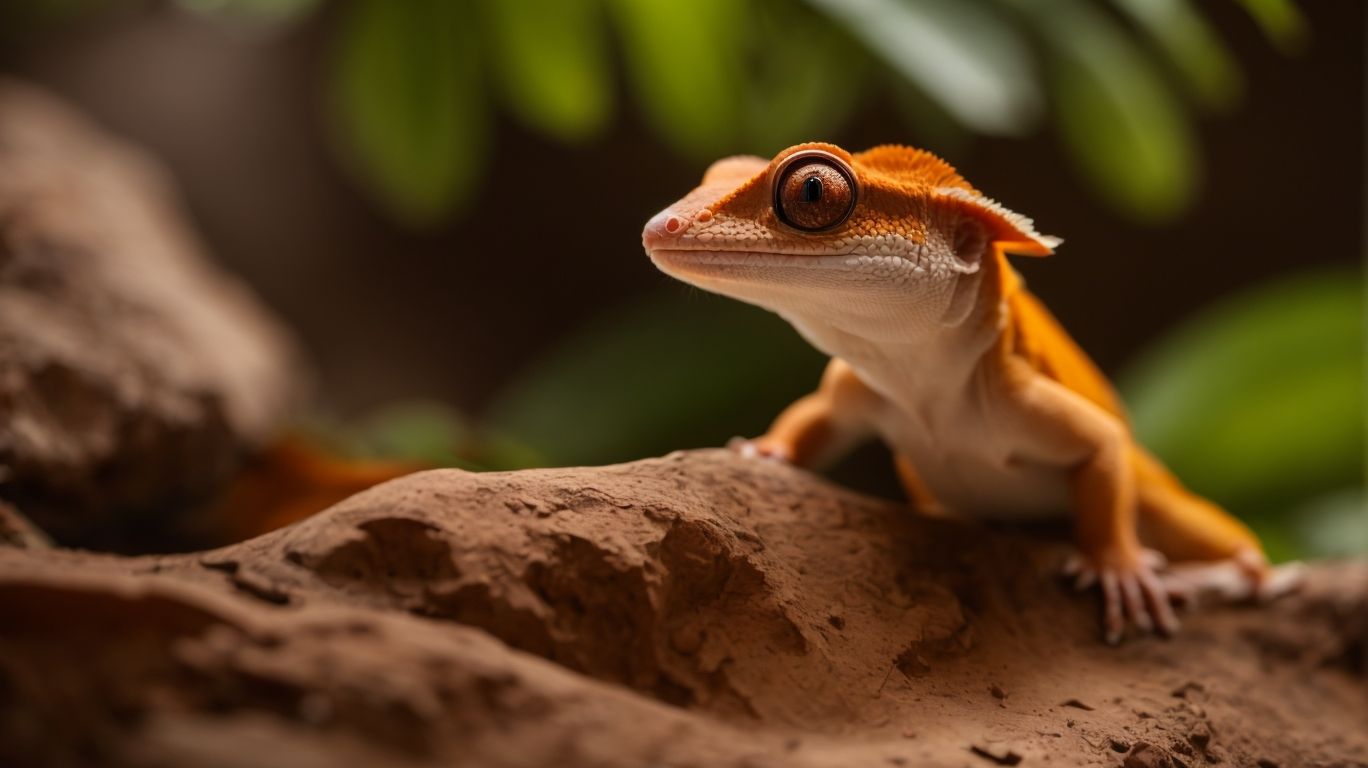
Axanthic Crested Geckos: Exploring This Rare Morph
If you’re a reptile enthusiast, you’ve probably heard of the stunning Axanthic Crested Gecko. But what exactly sets this rare morph apart from others?
In this article, we’ll delve into the world of Axanthic Crested Geckos, exploring their physical characteristics, behavior, and the genetics behind their unique appearance. We’ll also discuss the rarity of these geckos and the factors contributing to their scarcity. So, if you’re curious about how to care for these captivating creatures, read on to learn all about Axanthic Crested Geckos.
What Are Axanthic Crested Geckos?
Axanthic Crested Geckos are a rare morph of reptile that is popular among pet enthusiasts for their unique coloration and genetic characteristics.
Axanthic Crested Geckos are known for their striking lack of pigmentation, resulting in a stunning grayscale appearance. This captivating trait sets them apart from their more common counterparts, making them highly sought after by reptile collectors and enthusiasts.
Their genetic makeup offers breeders the opportunity to explore and produce fascinating color variations, adding to their allure. In terms of care, Axanthic Crested Geckos require a habitat with specific temperature and humidity levels, as well as a diet comprising insects and specialized fruit-based supplements. Their breeding potential makes them an intriguing choice for those interested in reptile genetics and morph development.
What Is a Morph in Crested Geckos?
In Crested Geckos, a morph refers to a specific genetic variation that alters the coloration, pattern, or scale characteristics of the gecko, often resulting in unique and visually striking appearances.
These variations are the result of genetic mutations that can produce an array of striking colors and patterns, making each morph distinct and desirable among enthusiasts and breeders.
Color mutations such as harlequin, dalmatian, and pinstripe are popular examples of morphs that have captivated reptile enthusiasts worldwide. These genetic variations play a significant role in breeding projects, as breeders aim to produce new and captivating morph combinations to satisfy the demand for unique and diverse Crested Geckos in the pet trade.
How Are Axanthic Crested Geckos Different from Other Morphs?
Axanthic Crested Geckos distinguish themselves from other morphs through their distinct lack of pigmentation, resulting in unique grayscale coloration and patterns that set them apart from traditional morphs such as albino or leucistic geckos.
Their grayscale coloration, characterized by shades of white, gray, and black, offers a striking contrast to the typical vibrant hues seen in other gecko morphs.
The patterns on Axanthic Crested Geckos can vary widely, with some displaying intricate speckling or banding, while others feature subtle variations in shading.
The genetic distinctions of Axanthic Crested Geckos are also noteworthy, as their unique alleles result in the absence of certain pigments, setting them apart in the world of gecko breeding and genetics.
What Are the Physical Characteristics of Axanthic Crested Geckos?
Axanthic Crested Geckos exhibit distinctive physical traits, including spiny crests, arboreal adaptations, and nocturnal behavior, along with unique eye and tail characteristics that contribute to their overall allure as pets.
The gecko’s tails are prehensile, helping them climb, and their eyes have vertical pupils that improve their vision at night. These geckos also have spiny crests from head to tail, making them even more captivating. Their ability to adapt to life in trees allows them to easily navigate through foliage, making them a popular pet for those fascinated by creatures that thrive in the dark.
How Do Axanthic Crested Geckos Behave?
Axanthic Crested Geckos are typically nocturnal and display arboreal behaviors, preferring elevated environments and demonstrating unique handling characteristics that cater to their arboreal nature.
These geckos are often found climbing on branches, walls, and other vertical surfaces, showcasing their adeptness at maneuvering in high places. Their nocturnal habits mean they are most active during the evening and night, making them an intriguing addition to any reptile enthusiast’s collection.
When handling Axanthic Crested Geckos, it’s important to approach them gently and maintain a calm demeanor to ensure they feel secure, given their skittish disposition. Providing plenty of climbing opportunities and hiding spots in their enclosure is crucial to satisfying their natural arboreal instincts.
What Are the Genetics Behind Axanthic Crested Geckos?
The genetics of Axanthic Crested Geckos involve complex mechanisms of color mutation, genetic inheritance, and breeding practices, often resulting in visually captivating morphs that are selectively bred in the captive-bred reptile community.
These mesmerizing morphs are a product of carefully planned breeding strategies that aim to bring out and enhance specific desirable traits. Understanding the inheritance patterns of axanthic traits is crucial for breeders, as it helps predict the outcomes of pairings and maintain the purity of the genetic lines.
The increasing popularity of captive-bred populations also contributes significantly to the conservation of these geckos, reducing the pressure on wild populations and preserving the genetic diversity of this fascinating species.
What Are the Inheritance Patterns of Axanthic Crested Geckos?
The inheritance patterns of Axanthic Crested Geckos involve diverse genetic combinations, contributing to the morph diversity and genetic richness within the gecko population. This showcases unique traits and color variations through selective breeding practices.
Selective breeding has allowed breeders to enhance specific traits in Axanthic Crested Geckos, such as color intensity, pattern variations, and overall appearance. This has resulted in the creation of various morph combinations, including super stripes, harlequins, and pinstripes, which have increased the fascination and appeal of these geckos within the reptile enthusiast community.
The genetic diversity and richness of Axanthic Crested Geckos continue to expand, making them a captivating subject for genetic studies and breeding projects.
What Are the Possible Outcomes of Breeding Axanthic Crested Geckos?
Breeding Axanthic Crested Geckos can lead to diverse outcomes, producing unique morph characteristics, color patterns, and genetic traits that contribute to the growing diversity of morphs within the gecko breeding community.
These outcomes are influenced by the interaction of different genetic traits, resulting in a wide array of color variations and patterns.
Breeders can observe variations in body color, dorsal patterns, and even eye color, making each breeding project a fascinating exploration of genetic potential. This diversity continues to drive excitement and innovation in the gecko breeding community, as enthusiasts strive to produce new and captivating combinations that showcase the full spectrum of possible outcomes.
How Rare Are Axanthic Crested Geckos?
Axanthic Crested Geckos are considered rare within the reptile community, with limited availability due to conservation efforts, prompting higher demand and pricing for these rare morphs in both pet trade and online markets.
Conservation efforts play a significant role in the rarity of Axanthic Crested Geckos. They are protected in their natural habitat and regulated in captive breeding programs. Wild-caught specimens are rarely found, further contributing to their scarcity.
The appeal of owning these unique morphs has resulted in a surge in breeding projects. However, the limited gene pool presents challenges. As a result, the pricing dynamics for Axanthic Crested Geckos reflect their scarcity, often commanding higher prices compared to other crested gecko morphs.
What Are the Factors That Contribute to Their Rarity?
The rarity of Axanthic Crested Geckos is influenced by various factors, including conservation initiatives, selective breeding projects, and the deliberate efforts to maintain genetic diversity through responsible breeding practices within the reptile community.
These initiatives have been pivotal in safeguarding the genetic integrity of Axanthic Crested Geckos, preventing their dilution and preserving their distinct characteristics.
Selective breeding projects have sought to enhance and propagate specific genetic traits, further contributing to the rarity of these geckos.
It is imperative for reptile enthusiasts to prioritize responsible breeding practices, as this not only ensures the health and well-being of the geckos but also plays a crucial role in sustaining the species’ genetic diversity for generations to come.
How to Care for Axanthic Crested Geckos?
Caring for Axanthic Crested Geckos involves providing a suitable terrarium environment, maintaining optimal temperature and humidity levels, offering a balanced diet, and addressing shedding and health considerations to ensure their well-being in captivity.
To create an ideal terrarium, it is important to integrate both live and artificial plants, as well as branches and hiding spots to mimic the natural habitat of your Axanthic Crested Geckos. Maintaining a temperature range of 72-80°F and a humidity level of 60-80% is crucial for their well-being.
Axanthic Crested Geckos thrive on a diet consisting of insects, fruits, and commercially prepared gecko diets. It is important to always provide access to clean water for your geckos. Regularly monitoring their health and looking for signs of distress is essential, and be sure to schedule regular veterinary check-ups to ensure their continued well-being.
What Are the Housing Requirements for Axanthic Crested Geckos?
Axanthic Crested Geckos necessitate specific housing conditions, including an arboreal terrarium setup with adequate humidity, temperature control, and ample space for climbing and perching to accommodate their natural behaviors and habitat preferences.
Geckos thrive in tall enclosures that mimic their natural habitat. This means providing vertical space for climbing and structures like branches and vines for them to perch on.
Maintaining proper humidity levels between 60-80% is crucial for their health. Additionally, a temperature gradient of 72-80°F during the day and a slight drop at night is necessary for their well-being. Including a variety of hiding spots and live plants can also improve their overall well-being in the enclosure.
What Do Axanthic Crested Geckos Eat?
The diet of Axanthic Crested Geckos primarily consists of live feeder insects, supplemented with nutritious blends and calcium supplements to ensure their dietary requirements and overall health in captivity.
Bearded dragons thrive on a variety of feeder insects. These can include crickets, roaches, and mealworms, which provide essential protein and nutrients for their diet.
It’s important to dust these insects with calcium and vitamin supplements before feeding them to your bearded dragon. This helps address their specific dietary needs and ensures they receive the necessary nutrients.
In addition to feeder insects, their diet should also be supplemented with gut-loaded insects, fruits, and powdered diets. This will provide a well-rounded nutritional intake and promote a balanced and healthy lifestyle for your bearded dragon.
What Are the Common Health Issues for Axanthic Crested Geckos?
Axanthic Crested Geckos may experience common health issues related to shedding complications, handling stress, and environmental factors, necessitating proactive care measures to address these concerns and maintain their well-being.
Shedding challenges can lead to retained skin, affecting the gecko’s mobility and overall health. These geckos are sensitive to stress, which can arise from improper handling or changes in their environment.
It’s crucial to provide a suitable habitat with proper humidity levels and temperature gradients to support their well-being. Monitoring their behavior and ensuring a balanced diet are also essential for their overall health and vitality.




No Comments